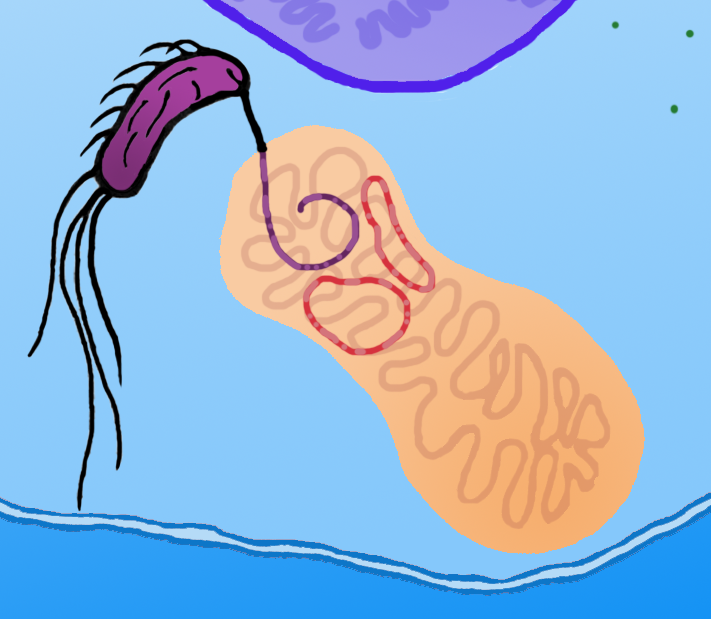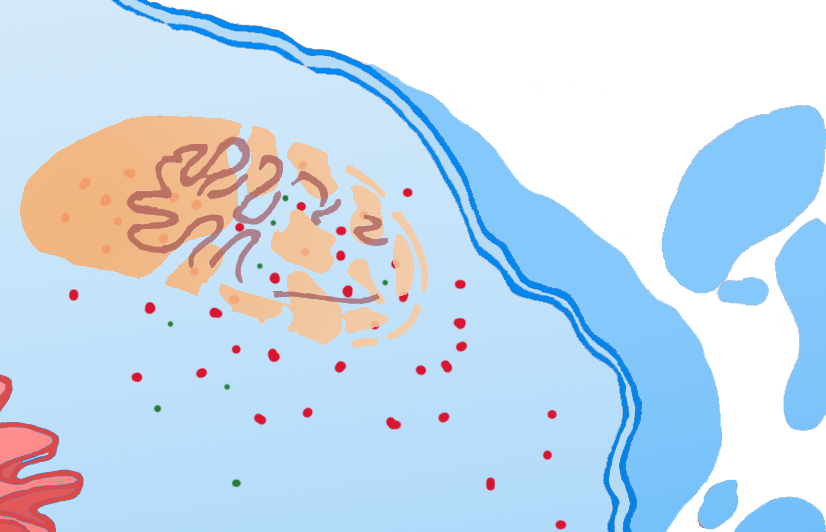Team:Warsaw/Project/theory
From 2009.igem.org
Theoretical basis
Contents |
Introduction
We have decided to use already existing systems responsible for virulency and invasiveness of different enteropathogenic bacteria, like Listeria sp., Yersinia sp. or Salmonella sp. We will also use some mammalian proteins responsible for induction of apoptosis. Below some basic ideas are introduced to make the understanding of the whole project simpler.
Entrance of bacteria into eukaryotic cells
Many bacterial species are capable of entering mammalian cells. One of the crucial proteins for this process is invasin. It is capable of selective interaction with integrins, which are present on external eukaryotic membrane. This triggers signalling cascade, indispensable to start endocytosis [9]. This interaction occurs via the invasin N-terminal domain, which is capable of promoting effective endocytosis of bacteria that synthesize invasin by cells normally unable to undertake phagocytosis [3]. The other protein which is involved in process of entering mammalian cells is internalin, which can be found on the surface of Listeria monocytogenes. Internalin is selecively interacting with cadherins found on the external eukaryotic membrane.
Escape from the phagosome
Although the induction of phagocytosis and entrance into the eukaryotic cell seems to be simple, this is not the final step of bacteria invasion. Majority of the enteropathogenic bacteria are incapable of dividing within the phagosome, but subsequently to leaving the phagosome they can proliferate rapidly within the cytoplasm. Escape from the phagosome is possible due to hemolysin, which causes membrane permeabilisation and phagosome disruption [16]. It was previously demonstrated that transfection with hemolysin-encoding gene is sufficient for enabling the escape from phagosomal vesicle of both Bacillus subtilis and Escherichia coli[1].
Process of escape from the phagosome is usually strictly regulated. Interesting example is the PhoP/PhoQ regulon, existing for example in Salmonella enterica ser. typhimurium LT2. It's a two-component regulatory system which reply to intramacrophage conditions like low pH or low metal ions concentration, leading to activation of PhoP-dependent genes, responsible for virulence of bacteria, like the MgtC gene.
Mitochondrial transformation
Electron transport chain functioning can be impaired by a variety of defects on the DNA level: not only point mutation and local deletions in genes encoding proteins of the chain, but also deletions of larger fragments or even of the whole mitochondrial genome (mtDNA). Correct mitochondrion contains 2 to 10 copies of mtDNA. Defects in mitochondrial DNA result in severe medical disorders especially in tissues which require large amounts of energy (such as nervous and muscle tissue). Effects of this impairments are neuro and myopathies [20]. The standard therapy based on bypassing interrupted pathways does not apply under these circumstances. Administration of enzyme cofactors and other metabolically active substances is not effective and may be applied only as supplementary therapy. We are forced to seek novel treatment strategies to cure patients suffering from mitochondrial disorders [7]. Currently the most commonly used method of mitochondrial transformation is the "gene gun" approach which is based on delivery of metal beads coated with DNA into the cell. This method is mostly limited to plants and fungi and has low therapeutic potential [7]. Current mammalian mitochondrial transformation techniques like electroporation also have serious limitations. Whole process takes place ex vivo and causes irreversible damage to the mitochondrion which make its efficient reintroduction into the cell almost impossible. The conjugation between bacteria and mitochondria is free from these side effects. Moreover, this phenomenon has been preformed in vitro.[22]. More recently a conjugation between two strains of bacteria within the cytoplasm of a mammalian cell has been observed . These findings suggest that conjugation between a bacterium and a mitochondrion is feasible [10].
Bacterial systems of protein secretion
Free living bacteria make use of diverse transport and secretion systems. In gram negative bacteria type I secretion systems are very common e.g. the well characterized hemolysin secretion system. hemolysin is responsible for pathogenicity of some E. coli strains. Obtaining a fusion of protein of interest with hemolysin C-terminus results in secretion of the protein into the growth medium[6] The same method can be used to secret bacterial proteins into the cytoplasm. This has already found its application in the new generation of vaccines[5].
Induction of apoptosis by p53
Mitochondrial outer membrane permabilization MOMP is one of the main programmed cell death mechanisms. The process is regulated by PTPc complex and Bcl2 family proteins [17]. Many cancer types involve disruption of this process therefore inducing MOMP in the tumour cells is regarded as potential therapeutic solution. MOMP-inducing factors include the p53 protein, which is mutated in almost half of the cancer cases. . By acting as a transcription regulator in the nucleus, p53 arrests the cell cycle and induce apoptosis [18]. In the cytoplasm p53 interacts with mitochondrial membrane and can enter the mitochondrion. It has been proven that these processes induce apoptosis and does not influence the cell cycle. In the mitochondrion p53 is an effector protein that activates soluble (cytochrom c, Smac) and insoluble (AIF, EndoG) apoptototic factors. Moreover interaction of p53 and Bax protein in vitro leads to permabilisation of lipid bilayer analogous to mitochondrial membrane. [12] Because p53 is inactive in tumour cells many research groups focused on designing gene therapies based on p53 gene delivery. Most frequently adenoviruses and eukaryotic plasmids were used. The results confirmed increased effectiveness of chemotherapeutic drugs following introduction of p53 gene copy into the cell [4]. It has been shown that p53 with the mitochondrial leader sequence alone is sufficient to induce apoptosis in mammalian cells. Fusion protein Lp53, with mitochondrial leader sequence from ornithine transcarbamylase was used. In terms of apoptosis induction fusion protein was almost as effective as standard p53. Previous research did not include delivery of p53 into tumour cells by bacterial vectors. Our project proposes a method to induce apoptosis without arresting the cell cycle. Cell cycle arrest decreases the sensitivity of cancer cells to chemotherapeutic agents, because they can affect only proliferating cells [14].
 "
"


